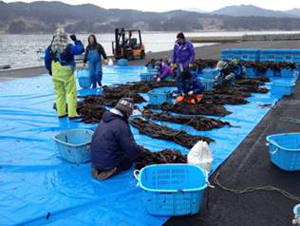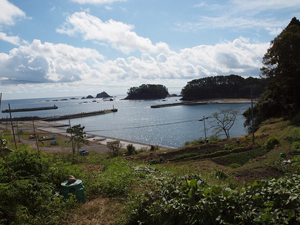Top>Opinion>Supporting Homeland Restoration Activities in Rikuzentakata: Looking Toward the Coming Millennium (Part 1)
 Index
Index

Masayoshi Tanishita [Profile]
Supporting Homeland Restoration Activities in Rikuzentakata:
Looking Toward the Coming Millennium (Part 1)
Masayoshi Tanishita
Professor, Faculty of Science and Engineering, Chuo University
Areas of specialization: Urban Engineering, Quantitative Spatial Analysis
1. Introduction
One year has passed since the Tohoku Region Pacific Coast Earthquake, a disaster that happens only once in several hundred years. It claimed the lives of over 15,000 people, with over 3,000 still missing. Furthermore, the subsequent power plant accident forced over 340,000 people to evacuate or relocate from their own homes.
What should we, and what can we who escaped severe damage do? With two objectives in mind, I have been involved with Rikuzentakata since April last year with a team that I created. One of the objectives is to help restore hopes and dreams. Hopes and dreams are born out of pride. We might be able to help people affected by the tsunami to restore their pride. Another objective is to reconstruct Japan's social structure and system. Farming and mountain villages are exhausted while a sense of helplessness is hanging over the government and diet. We also have global environmental problems. Confronted with these issues to tackle, the earthquake disaster reconstruction might provide us with an opportunity to establish a new future social structure, which requires efforts that transcend existing systems and frameworks as well as academic disciplines.
In this article, I would like to report the situation in Rikuzentakata since my two previous reports appeared on Chuo-Online and Chuo Hyoron, and describe what we have learned and done there.
2. Now, in the tsunami-stricken area
In temporary housing, which got through the winter, aggressive activities are currently under way to prevent deaths in isolation, building on the experience of the Great Hanshin Earthquake and Niigata Chuetsu Earthquake. To take an example, in Mobiria, which hosts 168 temporary houses, a group of people led by Mr. Gamou of the Rikuzentagada Yaoki Project![]() has launched activities such as watching over those in temporary houses and providing an assembly hall, which provides places and opportunities of exchange not only among people affected by the tsunami but with supporters from outside. The Tono Magokoro Net (The Tono City Disaster Relief Network) and Kanazawa University are conducting a footbath service, among other relief activities, in which supporters are trying to reach out to people affected by the tsunami by listening to their stories. In addition, the Riku Caf辿
has launched activities such as watching over those in temporary houses and providing an assembly hall, which provides places and opportunities of exchange not only among people affected by the tsunami but with supporters from outside. The Tono Magokoro Net (The Tono City Disaster Relief Network) and Kanazawa University are conducting a footbath service, among other relief activities, in which supporters are trying to reach out to people affected by the tsunami by listening to their stories. In addition, the Riku Caf辿![]() was created in Naruishi, Takata-cho through the initiative of local residents, and it has been operated mainly by them. Adjacent to clinics for internal diseases and digestive organs as well as dental offices, and equipped with web access, the caf辿 is a place for editing and sending information for college students and young people coming from all over the country. Last December, networking of these support groups was also realized.
was created in Naruishi, Takata-cho through the initiative of local residents, and it has been operated mainly by them. Adjacent to clinics for internal diseases and digestive organs as well as dental offices, and equipped with web access, the caf辿 is a place for editing and sending information for college students and young people coming from all over the country. Last December, networking of these support groups was also realized.
In the city of Rikuzentakata, not a few factories have been transferred to inland areas, and makeshift shopping streets have sprung up one after another in secured grounds. The latest development can be seen in the Rikuzentakata New Store Map![]() created by the Kanagawa Kintaro House, which shows that the center of the city has been relocated from Takata-cho to Takekoma-cho and Yonesaki-cho. Although many of the stores are temporary ones, there is no doubt that this trend will influence the shape of the post-disaster city.
created by the Kanagawa Kintaro House, which shows that the center of the city has been relocated from Takata-cho to Takekoma-cho and Yonesaki-cho. Although many of the stores are temporary ones, there is no doubt that this trend will influence the shape of the post-disaster city.
As for the fishing industry, common fishery has been initiated. I visited a fishing harbor in Hirota last March, where nine households were jointly harvesting wakame seaweed, using a pier which was still available due to the minimum ground subsidence. (Image 1)

Image 1: Harvesting wakame seaweed-the day's harvest was 4 tons
They told me that they would market the harvested wakame through their fishery cooperative association, but if producers and consumers can trade directly and cut middlemen margins, both sides can increase their satisfaction level. The sea urchin season is about to begin. It is said that the tsunami has swept out the sludge on the seabed and therefore oyster growth has been accelerated, but it will take at least a year to launch direct trade.
Another development to note is the initiation of the Earthquake Disaster Storytelling Tour![]() . Similar tours have already been launched in Minamisanriku, a hard-hit area like Rikuzentakata, with Hotel Kanyo as its base. In Rikuzentakata the tourism and local product association took the lead in preparation, and a tour was carried out on March 16. Tourism is an important industry in implementing the transition to the sixth industry in an area traditionally centered on primary industry.
. Similar tours have already been launched in Minamisanriku, a hard-hit area like Rikuzentakata, with Hotel Kanyo as its base. In Rikuzentakata the tourism and local product association took the lead in preparation, and a tour was carried out on March 16. Tourism is an important industry in implementing the transition to the sixth industry in an area traditionally centered on primary industry.
In addition to these initiatives, people are continuing their efforts to create jobs utilizing local resources, including business management seminars and business start-up support by Natsukashii mirai sozo kabushikigaisha![]() [a joint-stock company for the creation of a future which reminds us of good old days].
[a joint-stock company for the creation of a future which reminds us of good old days].
The reconstruction of the living environment is just as important as the restoration of work. Although community-wide movements for reconstruction can been seen in fishing communities like Hirota, this is not always the case in town areas. There are two methods for high ground relocation: the Collective Relocation Promotion Project for Disaster Prevention (Ministry of Land, Infrastructure, Transport and Tourism), under which low ground is taken into public ownership; and the Disaster Prevention Function Enhancement Project for Fishing Village (Fisheries Agency), under which it is possible to construct houses and other buildings by raising land without taking up the land. Examination is currently under way on which plan should be adopted, and a possibility to combine two plans for more efficient implementation is on the table. In addition, possible measures to secure lands for public housing, as well as plans for land readjustment projects including raising low grounds, are also in preparation. Consultation with governments over these issues, including the height of the tide wall, will start in the near future.
Apart from these community-wide activities, not a few people are making reconstruction efforts individually. Some anticipate another tsunami in the next few decades, while others think it will be in the next several hundred years. Some people must change their life options depending on their job, and uneasiness over employment and housing affects their health. It is a consummate period of the race against time.
3. Government activities
Accompanying these private initiatives, local government officials cut back their sleeping hours to prepare reconstruction plans. Like many citizens, government officials have been affected by the tsunami. Reconstruction-related projects are currently proceeding at a pace entirely different from those implemented before the disaster, and the capacity for clerical business and arrangement are in dire shortage.
Last September, the Great East Japan Earthquake Reconstruction Grants (a scheme in which the Cabinet Office, based on reconstruction plans of the affected municipalities, makes budgetary requests for relevant projects of each Ministry and distributes grants centrally to each municipality) was earmarked in the Third Supplementary Budget of FY 2011. Forty relevant projects were specified in October, and the budget finally passed the House of Representatives in December. Since then, municipal governments have been swamped with the work to prepare the grant related documents, which required to be submitted no later than January 31. As reconstruction plan needs to be approved by the municipal assembly in Rikuzentakata, it had to be completed until December. For a fifty-member Reconstruction Plan Examination Committee, sufficient discussion can never be expected. From November, explanatory meetings for local residents were held hurriedly in each district.
Regarding the tide wall, two general principles have been established through the course of events. One is the Act on the Promotion of Creating Tsunami Disaster Prevention Areas enacted in December. This Act stipulates that each municipality set up regional councils to examine comprehensive tsunami prevention measures, which are not solely dependent on the tide wall, but which combine soft measures such as securing evacuation routes and land use regulations.
Another significant development is that the heights of the tide walls has been determined throughout the Sanriku coast, based on the height of tsunamis of relatively high frequency, i.e., those that occur between once in several decades and once in a century and several decades. With these tsunamis as targets, the rise of the tsunami by sea embankment was taken into consideration in determining the height of each region. As for Rikuzentakata, newly presented heights are 12.5 to 12.8 meters, more than twice as high as the previous heights of 4.95 to 6.5 meters planned before the disaster. In the initial plan presented to the Reconstruction Agency, the start of construction work on the walls is scheduled to begin this April. (According to the Reconstruction Agency website, as of March 26, construction work is scheduled to begin in April in many fishing harbors.)
According to the reconstruction plan, as the result of a simulation about flooded areas and the depth of seawater when a tsunami of the same scale as this time rush to the coast and surpass the height of the tide walls, which are assumed to be 12.5 to 12.8 meters, the depth of seawater in the area around city hall has been estimated to be less than 3 meters. Therefore, the plan shows that it is possible to build houses by raising land by 5 meters. Of course, this result assumes that the tide walls and water gates are continuously maintained and will not be broken by the tsunami as big as this time.
Many opinions have been raised in opposition of constructing such high tide walls. The opinions include: walls would not only block the ocean view, but they would also limit the entrance and exit of vessels, and therefore hinder fishing. The walls would also detract from the appeal of the harbor, and there would be no young people, let alone tourists in the end, etc.
Basically, the height of tide walls should be discussed along with the land usage plan and evacuation system, taking costs not only for construction costs but also for long-time maintenance into consideration. An important task is to determine the height through comprehensive consideration of the coastal usage, environment, scenery, economy, and maintainability in each community, while securing conformity among competent authorities and adjacent coasts. In Rikuzentakata, consultation started from March 28th in Hirota district, but there is a problem: the construction of tide walls will be done as a disaster reconstruction project, and-even if it is planned, upon consultation with local residents, to lower the height of the tide wall more than was initially proposed in exchange for relocation to high grounds or securing evacuation sites or evacuation routes-the saved costs are not available for such projects.
The details regarding the tide walls, land readjustment project, and a memorial park were determined before local residents and city councilors had reached clear understanding. There was a mood that acquiring the reconstruction grant was of top priority and all the rest would be considered afterwards. Moreover, the deadline for the second reconstruction grants was March 31, and local governments were pressed to prepare the application materials.
4. Utilizing Rikuzentakata's History and Culture
Since last fall, we have been conducting activities to provide citizens with information not fully covered by the governments. We have organized study meetings utilizing the expert dispatch system of the Cabinet Office as well as workshops which were held surrounding a relief map, and in March a study tour was conducted in Hirota and Osabe districts in which 30 college students, including those from Chuo University, learned about the community from local residents. In the course of the tour, we also conducted research on liquefaction![]() that occurred in the Takata-Matsubara district as well as on tsunami monuments
that occurred in the Takata-Matsubara district as well as on tsunami monuments![]() which were created from the experiences of the two sanriku earthquakes that occurred in 1896 and 1933. The collected information will be a basis in considering the specific reconstruction plan in each community and district. As for Takata-Matsubara, a nationally designated Place of Scenic Beauty, we learned various things from the members of the Takata-Matsubara o Mamoru Kai [Association to protect Takata-Matsubara] about regeneration of the site, and we exchanged views on possible measures to facilitate the regeneration. Also, in Nesaki district of Hirota-cho, we learned that despite the tsunami as high as 15 meters, there were no tsunami victims in the district, because they observed a lesson engraved in a tsunami memorial that "you shall not build houses on grounds lower than this monument." I strongly felt that making a living using the low grounds as a workplace for fishing and farmlands is the prototype of tsunami protection measures. (Image 2)
which were created from the experiences of the two sanriku earthquakes that occurred in 1896 and 1933. The collected information will be a basis in considering the specific reconstruction plan in each community and district. As for Takata-Matsubara, a nationally designated Place of Scenic Beauty, we learned various things from the members of the Takata-Matsubara o Mamoru Kai [Association to protect Takata-Matsubara] about regeneration of the site, and we exchanged views on possible measures to facilitate the regeneration. Also, in Nesaki district of Hirota-cho, we learned that despite the tsunami as high as 15 meters, there were no tsunami victims in the district, because they observed a lesson engraved in a tsunami memorial that "you shall not build houses on grounds lower than this monument." I strongly felt that making a living using the low grounds as a workplace for fishing and farmlands is the prototype of tsunami protection measures. (Image 2)

Image 2: Nesaki harbor, Hirota-cho (photo by Mr. Goromaru Tsujino)
References and URLs
- Tanishita, Masayoshi. 2011. "The Great East Japan Earthquake: Rikuzentakata Restoration of the City and Support for It"
- Tanishita, Masayoshi. 2011. "Rikuzentakata-From Disaster Reconstruction to the Homeland Restoration" [Rikuzentakata-shinsai hukko kara furusato saisei e], Chuo Hyoron 278, pp. 61-68.
- Kono, Michihiro. March 2012. "Creating 'Rikuzentakata, a Town for Entrepreneurs'"[Kigyo no machi Rikuzentakata o tsukuru], Shincho 45, pp. 20-23.
- Kokusho, Takaji. "On Correlation between Disappearance of Pine Woods and liquefaction Caused by Tsunami" [Rikuzentakata deno tsunami ni yoru matsubara shoshitsu to ekijoka no kanren ni tsuite].

- Materials of the Green Infrastructure Study Association are available here.

- Masayoshi Tanishita
Professor, Faculty of Science and Engineering, Chuo University
Areas of specialization: Urban Engineering, Quantitative Spatial Analysis - Professor Tanishita was born in Ishikawa Prefecture in 1967.
He withdrew from the Doctoral Course, School of Engineering, the University of Tokyo, in 1992.
He became a Professor in 2008, on the Faculty of Science and Engineering, Chuo University, after assuming the positions of Associate Researcher at the University of Tokyo, Full-Time Lecturer in School of Engineering, at the University of Tokyo, Full-Time Lecturer, Assistant Professor and Associate Professor on the Faculty of Science and Engineering, Chuo University.
Area of specialization: Urban Engineering, Quantitative Spatial Analysis
Current areas of research: the external costs of automobiles and related tax systems, effects of regional planning and building agreement on the real estate market, physiological evaluation of walking space, management organization of public space, and the like.
- Research Activities as a Member of Research Fellowship for Young Scientists (DC1), Japan Society for the Promotion of Science (JSPS) Shuma Tsurumi
- Important Factors for Innovation in Payment Services Nobuhiko Sugiura
- Beyond the Concepts of Fellow Citizens and Foreigners— To Achieve SDGs Goal 10 “Reduce Inequality Within and Among Countries” Rika Lee
- Diary of Struggles in Cambodia Fumie Fukuoka
- How Can We Measure Learning Ability?
—Analysis of a Competency Self-Assessment Questionnaire— Yu Saito / Yoko Neha - The Making of the Movie Kirakira Megane








